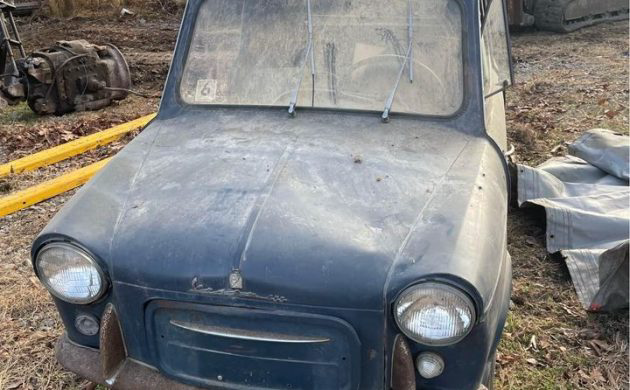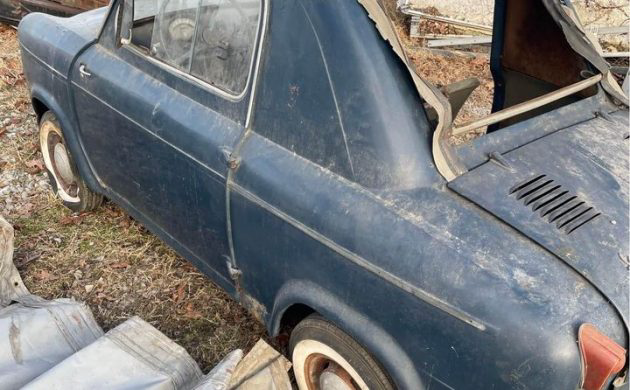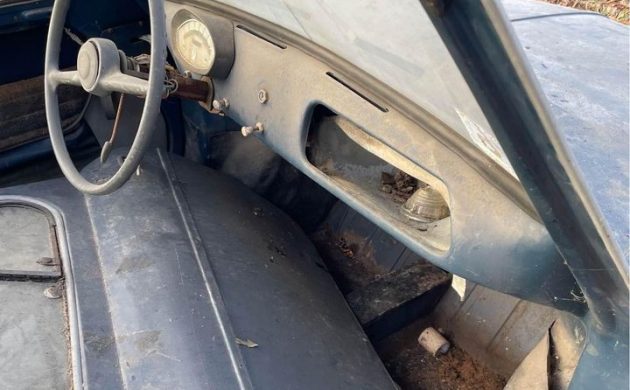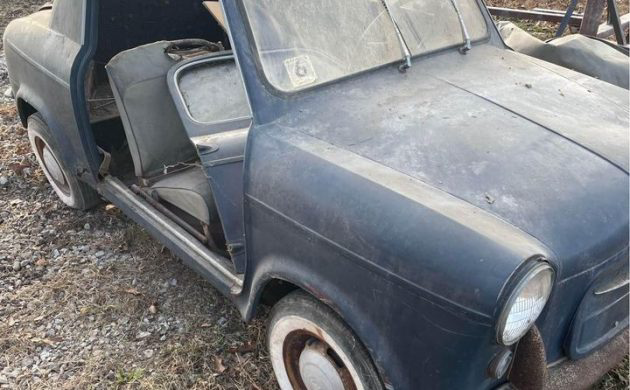If I described a car as a post-war classic designed by an Italian company, featuring a rear-mounted twin-cylinder engine and a sliding fabric sunroof, it would be easy to believe that I was describing a Fiat 500. However, another company followed the same design brief, and while they were Italian, their cars rolled off the production line in France. The vehicle in question is the Vespa 400. It is hard to believe, but this classic is even smaller than the iconic Fiat 500. It is also considerably rarer, and good examples fetch decent prices in today’s classic market. This one has been sitting for many years and could make a rewarding pintsize restoration project. Located in Slater, Missouri, you will find the Vespa listed for sale here on Facebook. The owner has set a sale price of $3,500 OBO.
The history of the Vespa 400 is slightly convoluted. Its parent company, Piaggio, envisage producing and releasing the car in Italy to compete with the Fiat 500 in the microcar sector. However, Fiat didn’t take kindly to the idea of competition and brought pressure to bear, which saw Piaggio eventually hand production to A.C.M.A. in France. The car caused quite a sensation when unveiled in Monaco in 1957. It came with an endorsement by three prominent Grand Prix drivers, although the names of these individuals seem to have been lost in the mists of time. The car went into production, and its first-year sales were, at best, modest. The company sold 1,103 examples, but that figure rocketed to 12,130 vehicles for 1958. Sadly, that was also the company’s strongest year, and after a further three years of disappointing sales, the model was discontinued at the end of 1961. There appears to be a small amount of confusion on the seller’s part with this Vespa. He listed it as a 1951 model, which cannot be correct. As we have seen, the first car didn’t appear until 1957, suggesting that there may be a typographical error in the listing. It seems that this little classic has spent many years stored indoors, and its overall condition looks surprisingly good. The fabric sliding roof is gone, and if the car had been sitting outside, that would have let plenty of water pool in the floors. That is always bad news when you are dealing with a vehicle of monocoque construction because it can be a catalyst for rust which can compromise the structural integrity of the car. The owner doesn’t mention any issues with the floors, so we need to keep our fingers crossed on that front. If there are no issues, that should make this a fairly straightforward project. There is evidence of external rust in a couple of spots, but the new owner could address these with patches. It appears that most of the trim is present, but it is another aspect of the car that would benefit from restoration. The glass looks good, which is a relief. Due to the low production total, finding replacement glass could be a challenge.
Life inside a Vespa represented motoring at its most basic. The company designated the vehicle as a two-seater but did offer an optional cushion that the buyer could fit to the rear cargo area to seat two small children. The seats are little more than tubular frames with plastic straps and cushion covers. Items like a radio and heater weren’t even mentioned, while the gauge cluster consisted of a speedometer and warning lights for low fuel and battery charge. It seems that the dash and wheel are intact on this car, as are the seats. Apart from the seats, there are no other upholstered surfaces. Door trims consist of sheets of plastic glued directly to the inside of the door skins. So tight is interior space that the company dispensed with the notion of wind-down windows. Their tracks and mechanisms consumed valuable elbow room, so the company opted for sliding glass. The owner supplies no engine photos but does indicate that one is present. It is no powerhouse, being a 393cc twin-cylinder air-cooled two-stroke engine with a power output of 14hp. Those ponies found their way to the road via a three-speed manual transmission, and the top speed on the Vespa can be heavily influenced by road gradient and headwinds. If the going was flat and there was no headwind, this 400 could climb its way to around 52mph. An unfavorable wind or heavy occupants could significantly impact that figure. The owner doesn’t indicate whether the engine turns freely, but if it does, that’s good news. Because it has been sitting for years, a refresh would seem advisable. A Vespa motor is no more complicated than a motorcycle engine, so rebuilding would not be difficult or expensive.
Piaggio had high hopes for the Vespa 400, but it was never a sales success. The scope of the failure can best be assessed when you compare the production figures of the Vespa with those of its perceived rival, the Fiat 500. While Fiat produced 3.2 million examples of their iconic 500, Vespa struggled to roll 30,976 of their vehicles off the French production line. The Vespa isn’t as instantly recognizable as the Fiat, but they still have a dedicated following in the classic car world. Fully restored to a high standard, this little gem has the potential to be worth close to $30,000 once complete. It may not be the most desirable vehicle on the planet, but there’s no doubt that it would start some interesting conversations at a Cars & Coffee. It is also an affordable project, and those two factors make it worth a closer look.











In fact, mechanical spare parts are not that hard if you buy from France. And panels glass etc would come from (many) cars previously broken for spares.
However, an open car sitting outside in Missouri doesn´t sound like a good beginning.
I don´t know about a GP driver endorsement for thie Vespa, but American driver Harry Schell certainly had one at the French GP at Rheims in 1957. Several fellow drivers took the car (Schell absent, celebrating his girlfriend´s birthday) and carried it up the stairs of Schell´s hotel,leaving it outside his room . So Vespas are light, as well as small…..
Fangio is the grand prix driver most associated with the Vespa 400. At the introduction of the 400 at the Paris auto show Fangio and Louis Chiron are seen inspecting the new Acma Vespa 400.
Lots of photos of Fangio and the 400 including the cover of the 25 Feb ’58 issue of Motor Rundschau exist.
Three factory entered 400’s ran in the1958 Monte Carlo rally starting from Stockholm Sweden then joining the rally completing 3,392 km without serious problems. For the brochure the kms are rounded to 3,390. Available on ebay.
In the summer of 1958 a semi-automatic oil mixing systems became standard. A photo of the engine compartment would make it clear whether this car is an early or later car.
A small number of 400 GTs were manufactured in 1961 with four speed gear boxes rather than the 3 speed.
This rather amusing, frustrating, humorous hodgepodge of still photos, brochures, contemporary and current videos offers a smogasbord of stock, modified, 400 to suit all tastes:
https://www.youtube.com/watch?v=0yGW8ZBQ1M0
ps: The clip of the yellow 400 zipping through NY City traffic is funny. It’s from the 2010 American film When in Rome with awful reviews.
One sold in the UK 2 years ago in dire condition for more than double that.
Posted a month ago.
Go old school and out a 900 Kawasaki motor in it or a Hayabusa motor, it would be a squirrelly ride.
“Uncle” Tom McCahill, I think it was, road-tested one of these in Central Park, and said it was the first car which he could test flat-out there without getting a speeding ticket. Of course the fact that he was not that much lighter than the car was probably a factor …
I got to do “pit duty” for a good friend at two of the Walter Mitty Challenge weekends at Road Atlanta – mostly running paperwork and fetching water – and another Nashville guy, older and with several cars, had one of these things as his pit vehicle. His racing, I have to say, took place partly in the pit area! At least the car was loud enough to warn everybody …
no trunk, a 2 stroke ta rattel ur teeth…I’d like one.
The rag top reminds me of many the others.
Is this one even smaller tho?